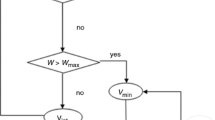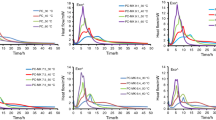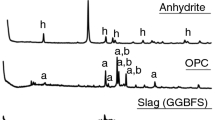Abstract
The use of by-product gypsum is an important alternative in concrete design. In present experiment, conduction calorimetry was applied to investigate the early hydration of calcium aluminate cement (CAC)/flue gas desulfurization (FGD) gypsum paste, supplemented with the determination of setting times and analysis of hydrates by X-ray diffraction (XRD). It was found that different profiles of heat evolution rate were presented depending on the CAC/FGD gypsum ratio. Two distinct exothermic peaks, associating with CAC hydration and ettringite formation respectively, appeared when the FGD gypsum content was less than 20%. Hydrate barrier mechanism was introduced to explain the difference in induction periods of the pastes with or without FGD gypsum. It is concluded that the blending of FGD gypsum accelerates the hydration of CAC for the quick formation of ettringite and generates greater hydration heat from per gram of pure CAC for the high exothermic effect of ettringite formation. The dissolution and diffusion of gypsum plays an important role of reacting controller during the hydrations of the pastes with FGD gypsum. The modified hydration process and mechanism in this case is well visualized by means of calorimetry.







Similar content being viewed by others
References
Hamm H, Kersten HJ, Hueller R. 25 years experience gained in the European Gypsum Industry with the use of FGD gypsum. Sonderdruck aus. 2004;4:92–102.
Guo XL, Shi HS. Thermal treatment and utilization of flue gas desulphurization gypsum as an admixture in the cement and concrete. Constr Build Mater. 2008;22:1471–6.
Tzouvalasl G, Rantis G, Tsimas S. Alternative calcium-sulfate-bearing materials as cement retarders: Part II. FGD gypsum. Cem Concr Res. 2004;34:2119–25.
Taylor HFW. Hydrated aluminate, ferrite and sulphate phases (p. 157–72); Calcium aluminate, expansive and other cements (p. 295–313). In: Telford T, editor. Cement chemistry. London: Academic Press; 1997.
Scrivener KL. High-performance concretes from calcium aluminate cements. Cem Concr Res. 1999;29:1215–23.
Glasser FP, Zhang L. High-performance cement matrices based on calcium sulfoaluminate-belite compositions. Cem Concr Res. 2001;31:1881–6.
Pacewska B, Wilińska I, Bukowska M. Hydration of cement slurry in the presence of spent cracking catalyst. J Therm Anal Calorim. 2000;60:71–8.
Nocuń-Wczelik W. Heat evolution in hydrated cementitious systems admixtured with fly ash. J Therm Anal Calorim. 2001;65:613–9.
Usherov-Marschak A, Zlatkovski O, Sopov V. Calorimetric study of frost attack during cement hardening. J Therm Anal Calorim. 2002;68:223–30.
Roszczynialski W. Determination of pozzolanic activity of materials by thermal analysis. J Therm Anal Calorim. 2002;70:387–92.
Sawków J, Nocuń-Wczelik W. Calorimetric studies of refractory corundum calcium aluminate composites. J Therm Anal Calorim. 2003;74:451–8.
Roszczynialski W, Nocuń-Wczelik W. Studies of cementitious systems with new generation by-products from fluidized bed combustion. J Therm Anal Calorim. 2004;77:151–8.
Nocuń-Wczelik W, Pytel Z. Heat evolution in hydrated cementitious systems admixtured with different set controlling components. J Therm Anal Calorim. 2004;77:159–64.
Badogiannis E, Kakali G, Tsivilis S. Metakaolin as supplementary cementitious material: optimization of kaolin to metakaolin conversion. J Therm Anal Calorim. 2005;81:457–62.
Tydlitát V, Tesárek P, Černý R. Effects of the type of calorimeter and the use of plasticizers and hydrophobizers on the measured hydration heat development of FGD gypsum. J Therm Anal Calorim. 2008;91:791–6.
Rahhal V, Talero R. Calorimetry of Portland cement with metakaolins, quartz and gypsum additions. J Therm Anal Calorim. 2008;91:825–34.
Baert G, Hoste S, De Schutter G, De Belie N. Reactivity of fly ash in cement paste studied by means of thermagravimetry and isothermal calorimetry. J Therm Anal Calorim. 2008;94:485–92.
Gu P, Fu Y, Xie P, Beaudoin JJ. A study of the hydration and setting behavior of OPC-HAC paste. Cem Concr Res. 1994;24:682–94.
Zhang F, Zhou Z, Lou Z. Solubility product and stability of ettringite. In: Proceedings of 7th international congress on chemistry of cement, vol. II. Paris, France; 1980. p. 88–93.
Regourd M, Thomassion JH, Baillif P, Touray JC. Study of the early hydration of Ca3SiO5 by X-ray photoelectron spectrometry. Cem Concr Res. 1980;10:223–30.
Gu P, Beaudoin JJ. A conduction calorimetric study of early hydration of ordinary Portland cement/high alumina cement pastes. J Mater Sci. 1997;32:3875–81.
Smrčková E, Palou M, Tomková V. Application of conduction calorimetry for study of the reactivity of C2S in the system C2S-C4A3Ŝ-CŜ-H. J Thermal Anal. 1996;46:597–605.
El-Didamony H, Khalil KA, El-Atter MS. Physicochemical characteristics of fired clay-limestone mixes. Cem Concr Res. 2000;30:7–11.
Asbrige AH, Page CL, Page MM. Effects of metakaolin, water/binder ratio and interfacial transition zones on the microhardness of cement mortars. Cem Concr Res. 2002;32:1365–9.
Saika NJ, Sengupta P, Gogoi PK, Borthaku PC. Cementitious properties of metakaolin-normal Portland cement mixture in the presence of petroleum effluent treatment plant sludge. Cem Concr Res. 2002;32:1717–24.
Acknowledgements
The authors acknowledge greatly the financial support of this work by the fund of Science and Technology Plan of Zhejiang Province, China (Project No. 2007C23055), Chinese National Programs for High Technology Research and Development (Project No. 2006AA03Z385) and New Century Excellent Scholar Program of Ministry of Education of China (NCET-04-0549).
Author information
Authors and Affiliations
Corresponding author
Rights and permissions
About this article
Cite this article
Guan, B., Lou, W., Ye, Q. et al. Calorimetric study of calcium aluminate cement blended with flue gas desulfurization gypsum. J Therm Anal Calorim 98, 737–742 (2009). https://doi.org/10.1007/s10973-009-0107-3
Received:
Revised:
Accepted:
Published:
Issue Date:
DOI: https://doi.org/10.1007/s10973-009-0107-3




